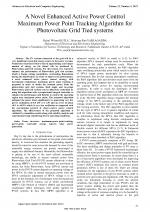| 3/2021 - 10 |
A Novel Enhanced Active Power Control Maximum Power Point Tracking Algorithm for Photovoltaic Grid Tied SystemsKOTLA, R. W. |
| Extra paper information in |
| Click to see author's profile in |
| Download PDF |
Author keywords
inverters, maximum power point tracking, power grids, renewable energy sources, solar power generation
References keywords
power(36), photovoltaic(15), electronics(14), systems(13), control(12), grid(8), yang(7), point(6), maximum(6), tracking(5)
Blue keywords are present in both the references section and the paper title.
About this article
Date of Publication: 2021-08-31
Volume 21, Issue 3, Year 2021, On page(s): 81 - 90
ISSN: 1582-7445, e-ISSN: 1844-7600
Digital Object Identifier: 10.4316/AECE.2021.03010
Web of Science Accession Number: 000691632000010
SCOPUS ID: 85115215877
Abstract
The PV systems connected to the grid will be a very significant renewable energy source in the power systems. Numerous researchers believe that in approaching years major amount of energy on the planet will be produced by Photovoltaic grid tied systems. For this reason, it is crucial to enhance the performance of Photovoltaic grid tied systems, which is facing voltage instabilities, overloading fluctuations during the disturbances. In order to improve the performance, a novel enhanced active power control strategy with incremental conductance maximum power point tracking is proposed in order to obtain the constant power from the photovoltaic grid tied systems. Both single and two-stage Photovoltaic grid tied systems can be effectively controlled by using this algorithm with a proportional integral controller to enhance the performance and flexible to control the operating region near maximum power point. The proposed algorithm mitigates the power losses significantly by generating very few power oscillations of 0.5 kW to 1 kW and an error of about +/-0.5 to +/-0.9% which is very less oscillation as compared with the conventional perturb & observe-active power control algorithm. The effectiveness of the proposed algorithm is validated by simulation results along with stability analysis and experimental setup considering diverse operating conditions. |
| References | | | Cited By |
Web of Science® Times Cited: 1 [View]
View record in Web of Science® [View]
View Related Records® [View]
Updated today
SCOPUS® Times Cited: 3
View record in SCOPUS® [Free preview]
View citations in SCOPUS® [Free preview]
[1] Grid Integrated Solar Photovoltaic and Battery Storage System Interfaced EV Charging Station and Healthcare Centre Load, Gupta, Kamlesh, Bhongade, Sandeep, Singh, Bhim, 2025 Fourth International Conference on Power, Control and Computing Technologies (ICPC2T), ISBN 979-8-3315-3040-2, 2025.
Digital Object Identifier: 10.1109/ICPC2T63847.2025.10958640 [CrossRef]
[2] Coordination of Fast and Slow Grid Edge Resources: A Model Predictive Control Approach, Du, Yuhan, Olowolaju, Joshua, Mohammadi, Javad, Livani, Hanif, 2025 IEEE Texas Power and Energy Conference (TPEC), ISBN 979-8-3315-4112-5, 2025.
Digital Object Identifier: 10.1109/TPEC63981.2025.10906791 [CrossRef]
Disclaimer: All information displayed above was retrieved by using remote connections to respective databases. For the best user experience, we update all data by using background processes, and use caches in order to reduce the load on the servers we retrieve the information from. As we have no control on the availability of the database servers and sometimes the Internet connectivity may be affected, we do not guarantee the information is correct or complete. For the most accurate data, please always consult the database sites directly. Some external links require authentication or an institutional subscription.
Web of Science® is a registered trademark of Clarivate Analytics, Scopus® is a registered trademark of Elsevier B.V., other product names, company names, brand names, trademarks and logos are the property of their respective owners.
Faculty of Electrical Engineering and Computer Science
Stefan cel Mare University of Suceava, Romania
All rights reserved: Advances in Electrical and Computer Engineering is a registered trademark of the Stefan cel Mare University of Suceava. No part of this publication may be reproduced, stored in a retrieval system, photocopied, recorded or archived, without the written permission from the Editor. When authors submit their papers for publication, they agree that the copyright for their article be transferred to the Faculty of Electrical Engineering and Computer Science, Stefan cel Mare University of Suceava, Romania, if and only if the articles are accepted for publication. The copyright covers the exclusive rights to reproduce and distribute the article, including reprints and translations.
Permission for other use: The copyright owner's consent does not extend to copying for general distribution, for promotion, for creating new works, or for resale. Specific written permission must be obtained from the Editor for such copying. Direct linking to files hosted on this website is strictly prohibited.
Disclaimer: Whilst every effort is made by the publishers and editorial board to see that no inaccurate or misleading data, opinions or statements appear in this journal, they wish to make it clear that all information and opinions formulated in the articles, as well as linguistic accuracy, are the sole responsibility of the author.



